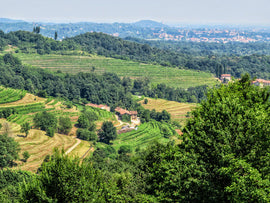Now, more than ever, I have come to appreciate how wine can be a gateway for exploration. While adhering to shelter-in-place, I’ve been traveling through my sense of taste and smell. This month it is time to once again fasten your organoleptic seatbelts as we traverse the enological autostrada to Tuscany and Campania. Italy, known by the Greeks as “Enotria,” land of wine, is home to an astonishing 2,000+ indigenous grape varietals. The country's glowing wine reputation is due not only to the fact that it produces and exports more wine than any other country, but that it offers the greatest variety of types, ranging through nearly every color, flavor and style imaginable. It’s always fun to taste
the unique flavors of a wine that are the result of grapes being grown in a particular area, soil, and climate. Our two wines this month offer a wonderful opportunity to experience the typicity of their region. Their flavors can carry you to the landscape from which they originate. Traveling through your sense of taste and smell to the foothills of the Appenine Mountains or the rolling coastal plain of Tuscany is only a sip away.
Campania is the ‘shin' of Italy's boot, anchored by its capital, Naples. Its name comes from Campania felix, a Latin phrase roughly meaning 'happy land’ or ‘fertile countryside'. Originally colonized by ancient Greeks, Campania is deeply rooted in culture, especially gastronomy, music, and architecture. The region is also rich in archaeology and is home to famous ancient sites such as Pompeii, Herculaneum, Paestum, and Velia.
Campania has historical links to wine and vines dating back to the 12th century BC, and is one of Italy's very oldest wine regions, with considerable influence from ancient empires, including the Greeks, Romans and Byzantines. Grapes like the region due to its abundance of sunshine, hot and dry summers, mild winters, volcanic soil, and cool winds from the Tyrrhenian Sea and the Appenine Mountains. Like many Italian regions, Campania is home to an impressive array of grape varieties, some of which are found almost nowhere else on earth. Eruptions of Mount Vesuvius over the centuries have laced the soils with ash and other volcanic deposits imparting a distinct minerality to the wines. The area is famous for producing Falerno (Falernum), one of the most ancient wines in Italy. The region has about 100,000 acres (46,800 hectares) of land dedicated to vines, and a great variety of micro-climates and terroir. Differences in temperatures, rainfall, and soil between coastal and inland areas account for variations in wines made from the same grape(s).
There are five provinces in Campania, each of them a wine-producing territory. The most renowned wine-producing province is Irpinia, which is the historical name of the province of Avellino. This is the home of the two most famous Campanian whites, Greco di Tufo and Fiano di Avellino. The name of the wines come from the grape variety and the particular commune with which they are associated - Greco from Tufo and Fiano from Avellino.
L’azienda Vitivinicola “I Favati” is located in Cesinali, a town in the heart of the Irpinia hills near Avellino. The Favati Family’s viticulture history dates back to 1915, and today the estate is run by brothers Piersabino and Giancarlo Favati and Giancarlo’s wife Rosanna Petrozziello. Giancarlo is the managing director and responsible for all business development. Piersabino is the coltivatore diretto, who oversees every aspect of production from farming to bottling, and Rosanna, a professional sommelier, is responsible for promotion, marketing and customer relations. Carmine Valentino is their consulting enologist. The cantina (winery) was constructed in the early 2000’s and utilizes state-of-the-art technologies in winemaking to complement their attentive, labor-intensive grape growing. The cantina is divided into three areas. The first area houses stainless steel tanks where the white wines are pressed and matured. The second is where vinification and bottling occur, and the third area is where the red wines are aged in barrels and then bottled.
I Favati’s 2018 Fiano di Avellino comes from the Pietramara Vineyard near the town of Atripalda, just outside Avellino. The vines, which average 18 to 20-years-old, are planted on a hillside that rises 1378 feet above sea level. The grapes for the 2018 were hand-harvested in the middle of October, then fermented in stainless-steel tanks, aged sur-lee, and bottled in April. I Favati’s Fiano di Avellino is a complex savory wine with pear, lime, lemon peel, herbs, and mineral character. It is medium-bodied, with fantastic fruit and a long finish. It can be enjoyed on its own as an aperitif, or pairs beautifully with Campania’s regional cuisine such as pesce spada al forno, baked swordfish that has been coated with garlic, breadcrumbs, Pecorino cheese, and parsley, then finished with a drizzle of lemon juice.
The 2018 I Favati Fian d’Avelino “Pietramara” is $22.00/bottle, $237.60/case.
The Antinori family’s commitment to the art of winemaking spans 26 generations and has endured since 1385, when Giovanni di Piero Antinori became a member of the “Arte Fiorentina dei Vinattieri”, the Florentine Winemakers’ Guild. Today, Albiera Antinori is the president of Marchesi Antinori, with the close support of her two sisters, Allegra and Alessia. Their father, Marchese Piero Antinori, is the current Honorary President of the company.
Tuscany’s Bolgheri region, situated along western Italy’s Tyrrhenian Coast about one hundred kilometers southwest from Florence, is land of the “Super Tuscan.” Its winemaking zone is made up of sloping coastal vineyards at the foot of the hills between the town of Bolgheri, after which this DOC is named, and the southern part of Castagneto. At the end of the Second World War, a Tuscan aristocrat, Marquis Mario Incisa della Rocchetta, who bred racing horses and had estates on the Tuscan coast, decided that he would plant Bordeaux varieties on his family estate, Tenuta San Guido. The Marquis had a taste for the wines of the Medoc and he noticed some similarity of maritime climate and soil between the gravel of the Medoc and the coastal plain in Tuscany. The first vineyards were planted in 1944 and the Marquis matured his wines in small barrels (barriques) on the French model, to the amazement of his workers. The Marquis married Clarice della Gherardesca, the sister of Carlotta della Gherardesca, wife of Nicolò Antinori. The Antinori family saw the potential in Bolgheri and began the process of commercializing the wine of Nicolò’s wife’s family, which was first sold in 1968. The wine was named ‘Sassicaia’, which means ‘stony ground’. Sassicaia showed that you could make world-class wines in Italy, and especially in unconsidered parts of Italy. Successive waves of investment followed, first in Bolgheri, and then more generally in the Maremma.
One of the biggest estates owned by Marchesi Antinori is Tenuta Guado al Tasso (formerly known as Tenuta Belvedere). Guado al Tasso, meaning “Badger’s Ford,” takes its name from a common sight at the estate. In the 1930’s, the property was inherited by Carlotta Della Gherardesca Antinori (Piero Antinori’s mother) and her sister Clarice. Clarice was married to Mario Incisa Della Rocchetta whose family had the nearby Tenuta San Guido. Spanning around 320 hectares, the estate is set in a beautiful plain encircled by rolling hillsides known as the “Bolgheri Amphitheater”. Guado al Tasso’s vines are planted at the foot of the amphitheater at an elevation between 145 and 190 feet above sea level. It’s a blessed position: the vineyards face the Tyrrhenian Sea, in a microclimate that cools the vines at night and allows the development of perfect ripeness and complex aromas. The area's alluvial soils, which vary from sandy-clay to silty-clay rich in agglomerate from Bolgheri (a very fine gravel), influence the character and personality of the varietals grown, and give them a distinctive territorial identity. The vineyards are planted to Cabernet Sauvignon, Merlot, Syrah, Cabernet Franc, Petit Verdot, and Vermentino Nero and Bianco. Renzo Cotarella, Antinori’s chief winemaker responsible for gems like Tignanello and Solaia, once said that the Guado al Tasso Estate could surpass Solaia in terms of vineyard quality.
“Il Bruciato”, a blend of 60% Cabernet Sauvignon, 30% Merlot, and 10% Syrah, is the second wine of Antinori’s Tenuta Guado al Tasso. The name Il Bruciato means “burned,” and refers to a wooded area on the Guado al Tasso estate that was destroyed by a famous fire in the early 1900s. The grapes for the 2017 Il Bruciato were picked by hand and immediately taken to the cellar for hand-sorting prior to destemming and crushing. Primary fermentation and maceration took place in stainless-steel tanks, and malolactic fermentation took place in both oak barrels and stainless-steel tanks. Once fermentation was complete, the wine was barrel-aged for seven months, followed by an additional four months in bottle before release. Reviewing the 2017, Antonio Galloni of Vinous wrote: “The 2017 Bolgheri Il Bruciato is pliant, supple and luscious, but what stands out most is how much freshness Antinori was able to keep in this wine. Dark red cherry, plum, spice, new leather and floral notes all meld together in this sumptuous, racy red.”
An antipasto platter with meats and rich hard cheeses or a lush mushroom lasagna with tangy tomato sauce and Parmesan will stand up to the flavors of the 2017 Il Bruciato. If you are looking to pair fish or seafood with this wine, go for rich, heartier dishes. A substantial seafood stew such as a Cioppino, a meaty swordfish with onions and capers, or seared tuna served with cannelloni beans and rosemary will work deliciously. Meat-based pizzas, veal parmesan, rich sausage dishes, or a hearty stew made with lamb, beef or pork will also highlight the complex flavors of this wine.
Tenuta Guado al Tasso’s 2017 Il Bruciato is $26.00/bottle, $280.80/case




